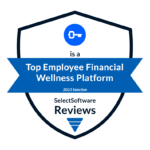With nearly 80% of workers concerned with basic expenses such as groceries and childcare, regardless of income, more employers are prioritizing benefits that help employees navigate and find solutions for their real financial needs: everyday money problems. In fact, about half of employers plan to have a comprehensive financial program in place by next year.
But designing this type of financial benefits strategy requires thinking beyond financial wellness programs, which usually involve a 401(k), financial education resources, coaching, or a few point solutions. This is not about abandoning what came before, but it is about giving employees meaningful support and real solutions for all of their financial challenges.
Here’s a closer look at the types of employee benefits employers are now prioritizing to achieve that goal.
1. Holistic financial support for all
Financial fragility is common as many employees struggle with rising living costs, medical bills, debt, childcare, and the inability to save for and/or weather financial emergencies. But these challenges don’t align neatly with age, income level, or life stage. Despite what is often reported in the media, not every Gen Z employee’s top financial priority is student loan debt help, just as not every Gen X employee is most concerned with saving for retirement. A 22-year-old frontline worker’s biggest financial challenge might be child care costs for her toddler, just as a high-earning middle-aged employee with no kids could be buried in credit card debt and late on rent.
That’s why employers are prioritizing holistic financial support that’s flexible, personalized, and includes relevant solutions across the full spectrum of financial needs, for all employees.
2. Emergency savings in the broader context of financial health
Workplace emergency savings accounts (ESAs) have gained popularity as a way to help employees build financial resilience. These programs typically allow automatic payroll contributions and sometimes include employer incentives.
But for the 70% of employees living paycheck to paycheck, ESAs alone may not be enough. Without support to manage debt, reduce expenses, or tap into available resources that help employees achieve financial stability, saving can feel out of reach.
That’s why employers are integrating emergency savings into more holistic strategies that help employees address the root causes of financial stress, so savings accounts become part of a broader system that supports employee wellbeing.
3. Student loan guidance based on the full financial picture
Student loan debt is a major source of stress for millions of Americans, but effective student loan support requires understanding the employees’ full financial picture. The “right move” depends on the individual’s unique priorities and challenges, but many student loan benefits are offered as one-off point solutions that don’t include that view.
As the student loan landscape becomes even more difficult for borrowers to understand and navigate, employers are integrating student loan support into comprehensive financial benefits that help employees evaluate their options in context to make informed choices that support their financial needs now and in the future.
4. Confidential, judgment-free, non-biased partners
Employees experiencing financial challenges may be ashamed and reluctant to use a benefit if they feel their employer will know about their situation. Likewise, some may perceive support from a certified financial planner or financial wellness coach as meant only for people who have money and want to know how to manage or grow it.
Removing any stigma around financial issues is a key driver of whether employees will trust an employee financial benefit enough to engage with and use it. That’s why employers are now prioritizing benefits that guarantee confidential and non-judgmental support and serve the full spectrum of financial needs, including crisis situations such as eviction or other types of hardship.
5. Front door concierge to the benefits ecosystem
Employees often miss out on valuable benefits they could access at no cost because they don’t understand how to use them — or realize they exist.
A more impactful approach integrates employees’ financial wellbeing into the broader benefits ecosystem, with benefits that help employees navigate to other providers, which may include a retirement solution, an EAP, mental health benefits, legal aid, and similar types of support to fully address the employees’ needs.
6. Access to real solutions that solve real problems
When someone is overwhelmed with everyday money challenges, they often don’t have the bandwidth to sort through information, compare options, or take any action – even when resources are technically available. That’s why more employers are shifting toward benefits that provide access to real solutions and personalized, hands-on support.
It’s not about telling employees what to do; it’s about helping them understand their options and empowering them to make choices and take steps to solve their challenges. For some employees, that might also require a partner who does the legwork to help them connect with a local emergency housing resource, secure assistance for late utility bills, or pursue debt consolidation or negotiation support, or a safe paycheck-linked loan. In other cases, it may simply mean providing the employee with access to a free interest-bearing savings account that makes it easy to save money from each paycheck, automatically.
All of these solutions help employees make real progress in addressing their problems and feeling hopeful about their financial potential – and that’s where real impact begins.
The bottom line
Employees’ financial priorities aren’t saving for retirement or accessing a lesson in money management when they’re worried about everyday money needs. That’s why more employers are rethinking their financial wellness strategy to offer comprehensive support that can also support these types of challenges, including times of crisis.
Employers who already made the shift by offering Brightside Financial Care see results including 41% less turnover on average, 50% of employees saving for emergencies, improved productivity, and 90% of employees who use their benefit self-reporting less financial stress.
To learn more about how Financial Care could evolve your strategy, click here.





